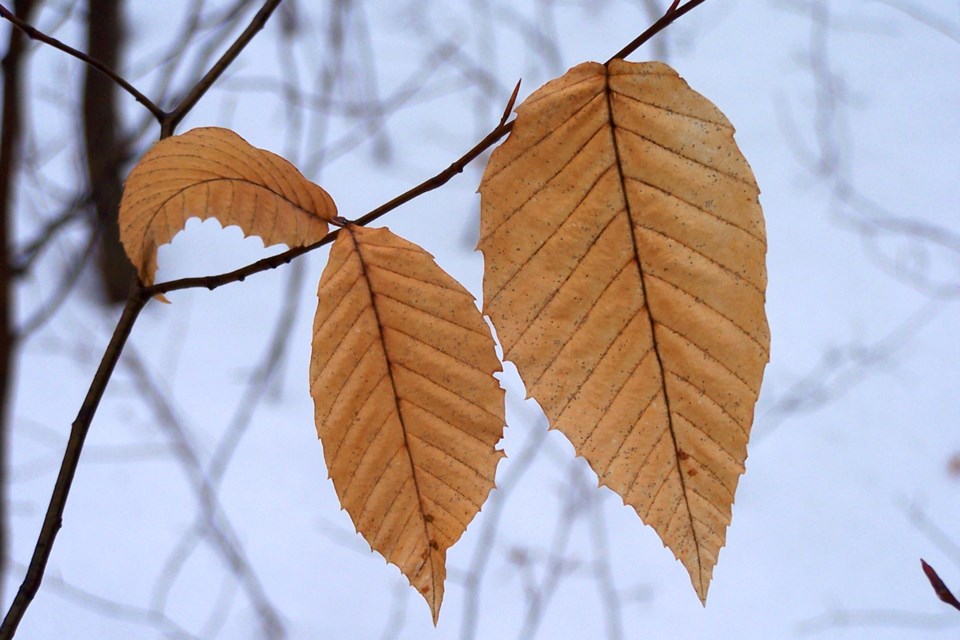Despite the gale force buffets of wind last week, the dead leaves attached to our oaks and beeches remain ... attached. What’s up with that?
Indeed, any wintertime walk through a hardwoods forest will reveal the brown and beige flags of red oaks and American beech fluttering in the chill breezes. Kind of nice, actually, seeing this muted splash of colour in an otherwise black and white world.
To understand why these trees are different we have to know why other hardwood trees are considered "normal" when they lose their leaves in October. It’s all about the abscission layer being present or absent.
Maples, birches, poplars and cherries, to name a few, shut down their leaf factories as the temperatures drop and daylight hours shorten. While the leaves were very productive during warm sunshiny moths, busy converting sunlight to sugar, inhaling carbon and exhaling oxygen, and transpiring water vapour, there comes a time when it is no longer viable to spend energy trying to keep a leaf happy and functioning.
The branch contains enzymes that start building a wall, cell by cell, between the old leaf stem and the new bud that’s starting to form. This wall eventually restricts, then prohibits, sap flow between the tree and the leaf. The leaf starves, dies and is snapped off at the weak abscission layer.
As an aside, this is the same process that happens on the head of a male deer when the now useless antler is shed. An abscission layer separates the two parts and, with a bonk and a shake, the old antler is left behind.
Back to trees ... where the old leaf was attached there is a new bud forming, a structure covered in bud scales (which are actually a special kind of protective leaf). These bud scales protect the unborn leaf or flower blossom all winter long, until warming weather once again pushes sap upwards and the buds then swell, break open from the bud scales, and grow a nice pretty green.
OK, so that’s the normal process. Where do oaks and beeches come in?
Well, before we get to that we have to look at the evolution of hardwood trees, as they weren’t always deciduous in nature. Apparently, once upon a time, all trees were conifers, often called evergreens, as they did not drop all their used leaves at the same time.
However, as the climates changed over the eras and millennia, the trees had a sustainability conference (so prove me wrong) and it was decided that some conifer trees needed to change their ways and start experimenting with short-lived and broadly shaped leaves as opposed to just thin waxy needles all the time. Oh, and change the way you make seeds as well, eh?
Thus, a great divergence in the history of botanical evolution and adaptations.
So nowadays we see conifer trees (pines, hemlocks, firs, cedars) with waxy coated needle leaves that restrict wintertime water loss due to transpiration and allow the tree to keep on living 24/7/12. And we see oodles of hardwood trees that are lumped as deciduous and now drop those useless leaves for the winter months.
OK, so where does that leave the oaks and beeches? Actually they are stuck in the middle of this great tree divergence, not having fully completed the shift to deciduous status. Their leaves are coarse and waxy, somewhat like a pine needle’s covering, yet the leaf has chugged along the evolutionary track long enough to be broadly shaped and is shut down for the winter months.
Lacking the enzymes to create an abscission layer, the beech and oak leaves belligerently hold tight, not knowing that they are supposed to be long gone from mama tree.
There have been inquiries made by inquiring minds as to the advantages, if any, of retaining these dead leaves? So far just a few theories have been floated, but nothing conclusive yet. One idea is that the dead leaves discourage twig browsing by deer and moose, thus saving the leaf buds until spring time.
Another thought is that the leaves act as a snow catcher and drop clumps of snow to the base of the tree, thus providing a little extra moisture for the roots in early spring.
A third notion is that the dead leaf provides frost protection to the newly growing bud, at least until the new guy pushes the old guy aside.
Whatever the reason, you will notice that this hanger-on characteristic only happens with young trees and the lower branches of mature trees. Again, what’s up with that? No one has that answer yet, either.
Next winter hike you are on, be sure to stop for a moment and check out the paper-thin and beautiful texture and colour of a beech tree leaf ... you are witnessing a dynamic (albeit very slow) step in evolution!



